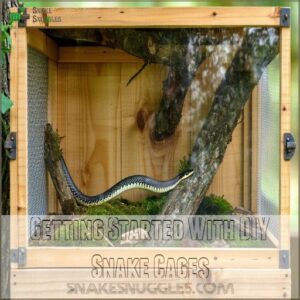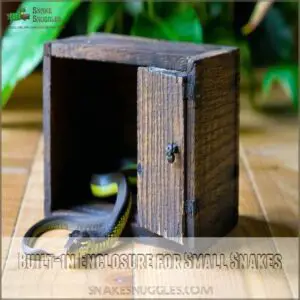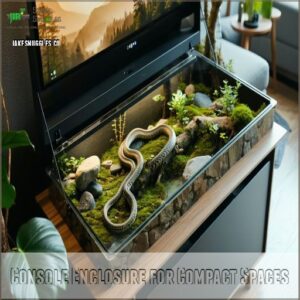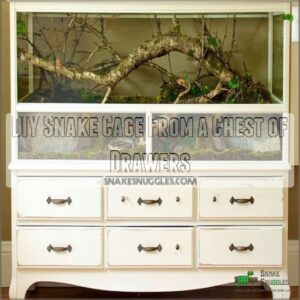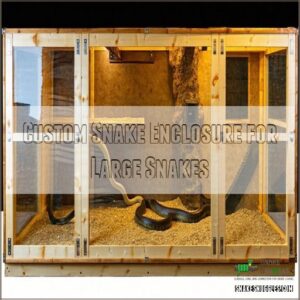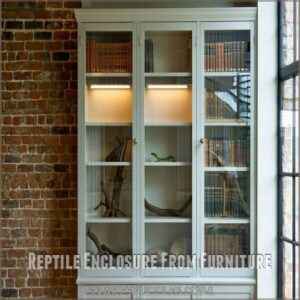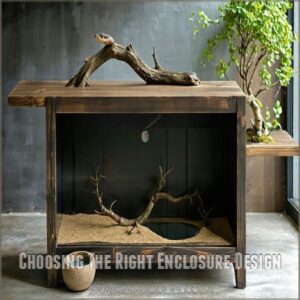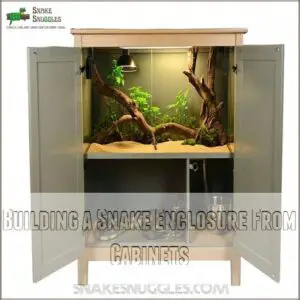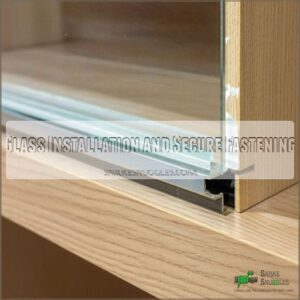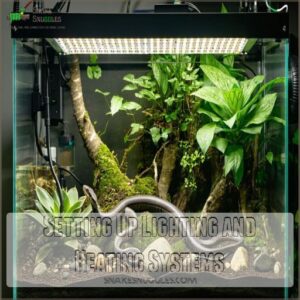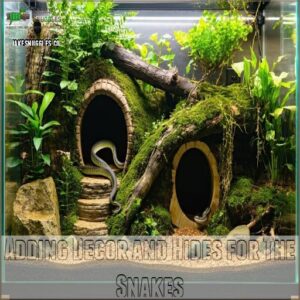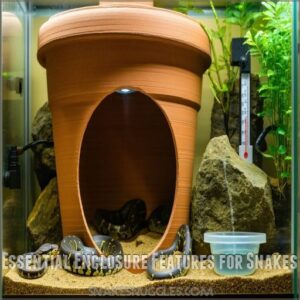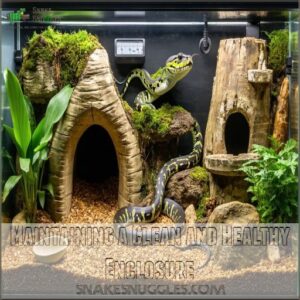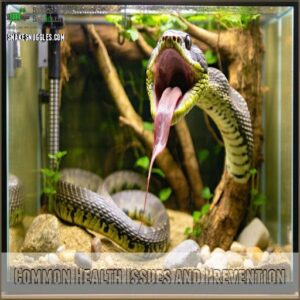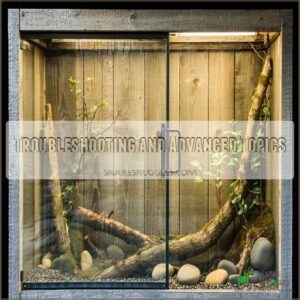This site is supported by our readers. We may earn a commission, at no cost to you, if you purchase through links.

Transform old furniture like cabinets, dressers, or shelving units into spacious enclosures by adding ventilation holes, secure glass panels, and proper lighting.
You’ll need waterproof materials, adequate space for your snake’s adult size, and essential features like hiding spots and temperature controls.
The trick is thinking like your snake – they need space to stretch, climb, and explore.
Consider building a multi-level habitat with climbing branches and integrated heating.
Many snake owners discover that custom DIY enclosures actually work better than store-bought ones.
Table Of Contents
- Key Takeaways
- Getting Started With DIY Snake Cages
- Top DIY Snake Cage Ideas for Beginners
- Choosing The Right Enclosure Design
- Building a Snake Enclosure From Cabinets
- Installing Glass and Setting Up The Enclosure
- Essential Enclosure Features for Snakes
- Maintaining a Clean and Healthy Enclosure
- Common Health Issues and Prevention
- Tips for Handling and Caring for Snakes
- Troubleshooting and Advanced Topics
- Frequently Asked Questions (FAQs)
- What is a DIY snake cage enclosure?
- How to make a snake cage?
- How to build a DIY snake enclosure?
- What is the best material for a snake cage?
- How to build a reptile cage?
- Can wire mesh be used in a snake cage?
- Can I build my own snake enclosure?
- What not to put in a snake enclosure?
- What is the best material for a snake enclosure?
- What should I put at the bottom of my snakes cage?
- What materials are safe to use for DIY snake enclosures?
- How do different snake species affect enclosure design choices?
- Can multiple snakes share a single DIY enclosure?
- Whats the best heating system for custom snake cages?
- How to waterproof wooden snake enclosure joints effectively?
- Conclusion
Key Takeaways
- You’ll save money and tailor a perfect fit for your snake’s needs by building a custom enclosure from materials like old furniture, wood, and glass.
- Focus on essential features such as proper ventilation, secure closures, and temperature control to ensure your snake’s health and comfort.
- Choose safe, moisture-retaining substrates like coconut husk or aspen shavings, avoiding harmful materials like pine or sand.
- Regular cleaning, monitoring temperature and humidity levels, and providing enrichment through decor and hides will keep your snake’s environment healthy and engaging.
Getting Started With DIY Snake Cages
You’ll save money and create the perfect home for your snake when you build a custom enclosure using basic materials like wood, glass, and hardware.
Building a custom enclosure can be done with a cabinet, bookshelf, or from scratch.
Whether you’re working with a cabinet, bookshelf, or building from scratch, you’ll need to focus on essential features like proper ventilation, secure closures, and maintaining the right temperature and humidity for your scaly friend.
Benefits of DIY Snake Enclosures
Building your own snake enclosure isn’t just a money-saver—it’s a chance to create something perfectly suited to your pet’s needs.
You’ll have complete control over dimensions, materials, and features while developing valuable DIY skills.
Plus, there’s something incredibly satisfying about crafting a custom home for your scaly friend.
The cost savings can be significant too, often 40-60% less than commercial options.
Common Mistakes to Avoid
Let’s take a look at the common mistakes that can trip up even experienced snake owners when creating DIY enclosures. Getting it right the first time will save you headaches down the road. Here are the most common mistakes to watch out for:
- Choosing an enclosure that’s too small for your snake’s adult size
- Skimping on proper ventilation and humidity control
- Using toxic materials or unsafe sealants
- Overlooking essential safety features like secure locks
Essential Materials and Tools
Now that you know what not to do, you’ll need the right tools and materials to get started.
Your toolbox should include a drill, saw, measuring tape, and safety gear like gloves and goggles.
For materials, grab plywood or melamine boards, silicone sealant, screws, and ventilation hardware.
Check local hardware stores or online marketplaces for the best deals on these supplies.
Top DIY Snake Cage Ideas for Beginners
You’ll find five budget-friendly snake enclosure designs that transform ordinary furniture into safe, comfortable homes for your scaly friend.
From built-in wooden boxes to repurposed console cabinets, these projects don’t require advanced carpentry skills.
These projects will save you hundreds compared to store-bought terrariums.
Built-in Enclosure for Small Snakes
A wooden box and plywood foundation creates the perfect built-in enclosure for your small snake.
You can find a variety of wood options for your snake cage at stores like snake cage wood suppliers.
You’ll need some hot glue to attach the plywood base securely.
The best part? You can stain or paint it to match your home’s style.
This design works great for corn snakes, ball pythons, and other smaller species, giving them a cozy space that looks like custom furniture.
Console Enclosure for Compact Spaces
Looking to maximize your living space while giving your snake a cozy home?
A console enclosure offers the perfect solution.
Remove the cabinet’s bottom panel, secure plywood for the base with screws, and add plexiglass sheets for ventilation.
You’ll create a sleek, space-saving habitat that’s easy to clean and fits perfectly against any wall.
The cabinet’s design keeps everything tidy and accessible.
DIY Snake Cage From a Chest of Drawers
Converting a chest of drawers into a snake enclosure opens up creative possibilities while saving money.
To make sure you have a healthy environment, you’ll want to think about a material that can withstand moisture, such as melamine, which is moisture-resistant options.
With hardboard, adhesive, silicone, and vinyl flooring, you’ll transform unused furniture into a perfect snake home.
The built-in storage drawers keep supplies organized and within reach.
- Feel proud knowing you’ve given old furniture new life
- Experience satisfaction from creating a unique home for your pet
- Enjoy the convenience of having everything in one organized unit
- Save money while building something truly special
- Gain confidence in your DIY abilities with each step completed
Custom Snake Enclosure for Large Snakes
Large snakes need custom enclosures that match their size and specific needs.
You’ll want to build a frame using sturdy wood, then add plexiglass windows for easy viewing.
The beauty of custom builds? You can adjust dimensions to fit any space or alcove in your home.
Plus, you’re not limited by standard sizes – your snake gets exactly what it needs, from custom heating zones to unique climbing features.
Reptile Enclosure From Furniture
A bookcase can transform into your snake’s dream home with just a few smart tweaks.
Turn it on its side, remove the shelves, and you’ve got a solid foundation for a custom enclosure.
Here’s what makes this setup shine:
- Acrylic front panel provides clear viewing
- Built-in spots for lighting and heating
- Extra storage space for supplies
Plus, you’ll save money while giving old furniture new life.
Choosing The Right Enclosure Design
You’ll need to weigh several factors when choosing the perfect enclosure design for your snake, including the size of your pet, available space in your home, and your budget.
Whether you’re considering a built-in wooden box, console cabinet, or converted furniture piece, you’ll want an enclosure that provides proper ventilation, easy cleaning access, and enough room for your snake to stretch out comfortably.
Factors to Consider for a Snake’s Habitat
Your snake’s ideal habitat depends on several critical factors that’ll make or break their comfort.
Here’s what you need to match with your snake’s specific needs:
| Factor | Why It Matters |
|---|---|
| Snake Size | Determines minimum enclosure dimensions |
| Species Type | Affects humidity and temperature requirements |
| Natural Habitat | Guides substrate and decoration choices |
| Activity Level | Influences climbing space needs |
| Feeding Habits | Impacts cleaning frequency and layout |
Remember: A happy snake is one whose home mimics their natural environment as closely as possible.
Understanding Ventilation and Lighting Needs
Proper ventilation and lighting setup makes the difference between a thriving snake habitat and a potential health hazard. While snakes aren’t exactly sunbathers, they need specific lighting conditions to stay healthy:
- Install mesh vents at both ends to create cross-ventilation and prevent respiratory issues
- Position UVB lights to cover 2/3 of the enclosure for proper calcium absorption
To guarantee safe basking temperatures, invest in a reliable heat lamp guard, such as those found on heat lamp accessories, to prevent burns and maintain a stable environment.
- Set up heat lamps with guards to maintain safe basking temperatures
Selecting The Perfect Substrate for Snakes
Selecting the right substrate is both an art and a science when it comes to snake care.
You’ll want something that retains moisture for proper humidity while being easy to spot-clean.
When choosing a substrate, it’s also important to avoid materials like sand and pine shavings that pose health risks to your pet snake.
Consider coconut husk for its excellent moisture retention, aspen shavings for burrowing species, or reptile carpet for hassle-free maintenance.
Whatever you choose, make sure it’s at least 2-3 inches deep for proper thermoregulation and natural behaviors.
Building a Snake Enclosure From Cabinets
You’ll love how a basic cabinet can transform into a secure home for your snake, with plenty of room for custom features like heat panels and proper ventilation.
With just $255 and some basic tools, you can build a professional-looking enclosure that’s both easy to clean and perfectly suited to your snake’s needs.
Acquiring The Foundation and Cabinets
Smart bargain hunters know that local classifieds are your ticket to affordable snake enclosure foundations.
Look for vertical cabinets around 72" high, 20" wide, and 18" deep – these dimensions work perfectly for most snake setups.
While browsing, keep an eye out for sturdy used cabinets or shelving units that could house Exo-Terra enclosures or be modified to fit larger bins as your snake grows.
Demolishing and Reconstructing The Cabinet
Once you’ve got your cabinet ready, it’s time for some heavy lifting.
Start by removing the flimsy back panel – it’s usually just thin melamine that won’t hold up over time.
Next, take out that highest fixed shelf to maximize space.
A hand saw works great here (just watch those fingers!).
Replace the back with sturdy hardboard – it’s thicker and more durable than the original panel.
Sealing and Flooring for Easy Cleaning
A properly sealed snake enclosure is your first line of defense against moisture and bacteria.
When selecting materials, consider using reptile enclosure essentials like PVC panels or melamine-coated wood for durability and ease of cleaning.
Apply No More Nails adhesive around the cabinet’s perimeter before attaching the hardboard back panel. Secure with screws, then seal all seams using GE Silicone I – never Silicone II, which contains toxic mold inhibitors.
Install vinyl flooring on the bottom and back wall for easy cleaning and a sleek look.
Installing Glass and Setting Up The Enclosure
You’ll need to install the glass panels and tracks with precision to create a secure environment that prevents your snake from escaping.
You can then set up the heating system, add proper lighting, and arrange decorative elements like hides and branches to make your snake feel at home.
Glass Installation and Secure Fastening
Installing glass panels is like putting together a puzzle – every piece needs to fit just right.
Start with tracks from your local glass shop, securing them to the cabinet using No More Nails Adhesive.
Choose tempered glass for safety and durability.
Apply a thin bead of GE Silicone I along the tracks, then carefully slide in your glass panels.
Let everything cure for 24 hours before testing.
Setting Up Lighting and Heating Systems
With the glass securely in place, let’s power up your snake’s environment.
Proper lighting and heating create a cozy home that mimics your snake’s natural habitat.
Mount LED strips along the top track for ambient light, and secure your heat lamp about 12 inches above the basking spot.
Don’t forget to connect everything to a thermostat – it’s like giving your snake its own climate control system.
Adding Decor and Hides for The Snakes
After setting up your heating and lighting systems, it’s time to make your snake’s space feel like home.
Place at least two hides – one on the warm side and another on the cool side.
Natural cork bark, hollow logs, or DIY hides made from ceramic pots work great.
Add fake plants, branches, and rocks to create climbing opportunities and make the enclosure both functional and visually appealing.
Essential Enclosure Features for Snakes
You’ll need to outfit your snake’s enclosure with specific features that keep it healthy and content, including proper hiding spots, reliable temperature control, and easy access to fresh water.
Your snake’s comfort and safety depend on these essential elements working together, from maintaining the right humidity levels to providing secure visual barriers that help reduce stress.
Hiding Spots and Visual Barriers
Your snake’s privacy matters as much as the glass and lighting setup.
Think of hiding spots as your pet’s personal retreat – they’ll need at least two secure spaces to feel safe.
Cork bark rounds, artificial caves, or repurposed cardboard boxes (temporarily) work great.
Place visual barriers like fake plants or bamboo screens strategically around the enclosure to create a sense of security.
Water and Food Bowls for Hydration and Nutrition
While setting up proper water and food bowls might seem straightforward, getting it right makes all the difference in your snake’s health.
For water bowls, consider a heavy ceramic water dish for stability and easy cleaning. Choose sturdy, escape-proof bowls that won’t tip over during your pet’s adventures.
Here are three key features to nail down:
- Pick bowls wide enough for full-body soaking
- Position them away from heat sources
- Clean daily to prevent bacterial growth
Temperature and Humidity Control Systems
A reliable temperature and humidity control system acts as your snake’s personal climate controller.
Install a combination of heating elements like ceramic heat emitters or radiant panels to create proper thermal gradients.
Monitor both parameters with digital gauges placed at different heights.
For humidity management, use automated misters or manual misting, and incorporate proper ventilation to prevent moisture buildup while maintaining ideal conditions.
Maintaining a Clean and Healthy Enclosure
To create an optimal environment, it’s essential to design a layout with a temperature gradient, complete with hiding spots, a basking spot, and thermoplastic terrarium panels. You’ll need to stay on top of your snake’s enclosure maintenance to help your pet thrive in its habitat.
Enclosure maintenance isn’t just about appearances – it’s essential for preventing respiratory infections, parasites, and other common health problems that can affect your scaly friend.
Cleaning Frequency and Disinfection Methods
Setting up the perfect environment for your snake is just the start – keeping it clean is what makes it truly shine.
Clean your snake’s enclosure thoroughly every two weeks using pet-safe disinfectants.
Focus on spot-cleaning daily, wiping down surfaces, and sanitizing water bowls.
Pro tip: Mixing one part vinegar with nine parts water creates an effective, natural cleaning solution that won’t harm your scaly friend.
Substrate Choice and Replacement
Inside your snake’s enclosure, the right substrate acts like a comfy mattress while helping maintain cleanliness.
Choose between coconut husk, cypress mulch, or reptile carpet based on your snake’s species.
Replace substrate completely every 4-6 weeks, spot clean daily, and consider layering approaches for better waste management.
Newspaper makes an affordable backup option when you’re between substrate changes.
Monitoring Temperature and Humidity Levels
After replacing your substrate, turn your attention to tracking your snake’s climate.
Just like we check our phones for weather updates, you’ll want to keep tabs on your snake’s environment.
Here’s what to monitor daily:
- Use digital thermometers at both ends of the enclosure
- Place hygrometers in different zones to track moisture
- Record readings twice daily in a log
- Check probe placement regularly for accuracy
Common Health Issues and Prevention
You’ll need to watch out for common health issues like respiratory infections and mouth rot that can affect your snake in its DIY enclosure.
Regular cleaning, proper ventilation, and maintaining the right temperature and humidity levels will help prevent most health problems and keep your scaly friend thriving in its custom home.
Respiratory Infections and Treatment
Your snake’s enclosure requires proper ventilation, such as that found in a well-designed boa constrictor enclosure size, to prevent respiratory issues. Your snake’s respiratory health is a top priority in their enclosure setup.
Watch for wheezing, bubbling around the nostrils, or open-mouth breathing – these are red flags for infection.
Regular cleaning, proper humidity levels (40-60%), and a suitable [temperature and humidity gradient](https://snakesnuggles.com/how-to-prevent-snake-respiratory-infection/#:~:text=Keep your pet snake healthy and happy by learning to) help prevent these issues.
If you spot symptoms, don’t wait – maintain ideal temperatures (75-85°F) and get your snake to a reptile vet promptly.
Mouth Rot and Parasite Prevention
Preventing mouth rot and parasites starts with maintaining pristine enclosure conditions.
Clean your snake’s cage thoroughly every two weeks, removing all waste and old substrate using quality products from a trusted snake cage cleaning supplier reliable snake cleaning.
Keep the humidity balanced – not too wet or dry – since excessive moisture breeds bacteria.
Monitor your snake’s mouth for any redness, swelling, or discharge.
A varied diet from trusted sources helps ward off internal parasites naturally.
Regular Veterinary Check-Ups and Care
Schedule regular vet check-ups for your snake every 6-12 months, just like clockwork.
A qualified reptile vet can spot early signs of health issues before they become serious problems.
They’ll check your snake’s weight, assess their skin condition, and screen for parasites.
Between visits, keep detailed records of feeding, shedding, and behavior patterns – this information helps your vet provide the best possible care.
Tips for Handling and Caring for Snakes
You’ll need to consider the minimum enclosure size for your pet snake, such as the recommended 2/3 the length of the snake to allow for natural behaviors like climbing and stretching in a suitable cage size for a snake. You’ll need more than just a great enclosure to keep your snake healthy and happy in its DIY home.
Proper handling techniques and nutrition requirements are crucial.
Creating an enriching environment that’ll help your scaly friend thrive in their custom-built habitat is also essential.
Handling Techniques and Safety Precautions
Along with proper enclosure setup, mastering safe handling techniques keeps both you and your snake stress-free.
Think of handling like building trust – start slow and steady.
Here’s what experienced keepers swear by:
- Always wash hands before and after handling
- Support your snake’s body length, never grab the tail
- Stay calm and move deliberately during handling sessions
- Keep handling sessions under 15 minutes initially
Feeding and Nutrition for Snakes
Most snake owners face the challenge of getting their feeding routine just right.
You’ll want to match prey size to your snake’s body width – typically about 1.5 times their girth.
Feed pre-killed frozen mice or rats (thawed to room temperature) rather than live prey to prevent injury.
Space feedings every 7-14 days for adults, and supplement with calcium powder every third meal.
Providing a Stimulating Environment
After mastering your snake’s feeding routine, it’s time to make their space more engaging.
Your snake’s terrarium should feel like a mini adventure park, packed with opportunities for enrichment and natural behaviors.
Mix up the enclosure layout monthly to keep things fresh and encourage exploration.
- Add branches at different heights for climbing and muscle development
- Create multiple hiding spots using cork bark and artificial plants
- Rotate different substrate types seasonally for new textures and burrowing experiences
Troubleshooting and Advanced Topics
You’ll find essential solutions for common snake enclosure challenges, from preventing escapes to customizing features for specific species.
Whether you’re dealing with a sneaky ball python or an active corn snake, we’ll show you advanced building techniques that’ll keep your pet secure and comfortable in their habitat.
Escape Prevention and Emergency Procedures
Proper snake handling builds trust, but even experienced keepers face escape attempts.
Double-check your enclosure’s weak spots – gaps around cables, loose vents, or unsecured lids are common culprits.
Keep an emergency kit ready with thick gloves, snake hooks, and flashlights.
If your snake escapes, search warm spots first and lay out flour near walls to track movement.
Stay calm – most escapees are found within 48 hours.
Advanced Enclosure Designs and Features
Taking your snake’s enclosure to the next level doesn’t have to be complicated.
Smart automation systems can control temperature, humidity, and UVB lighting cycles, making care easier.
Add custom ventilation ports with automated fans to maintain perfect airflow, and install security cameras to monitor your pet remotely.
You can even integrate feeding schedules and cleaning reminders into a simple smartphone app.
Customizing The Enclosure for Specific Snake Species
For specific snake species, your enclosure design needs to match their natural habitat.
Ball pythons thrive in slightly larger spaces with higher humidity, while corn snakes prefer drier conditions with plenty of climbing spots.
Consider your snake’s adult size when planning the right enclosure size for its life stage, such as a baby boa constrictor enclosure size. A baby boa constrictor will need a much bigger setup than a full-grown rosy boa.
Match heating, lighting, and substrate accordingly.
Frequently Asked Questions (FAQs)
What is a DIY snake cage enclosure?
When building a DIY snake cage, consider the ideal bull snake enclosure size to ensure ample space for your pet. A DIY snake cage enclosure offers a customized, affordable habitat for your slithery friend.
Use materials like wood, plexiglass, or furniture to create a safe, stylish home, addressing essentials like ventilation, lighting, and secure construction.
How to make a snake cage?
Start by sourcing a used cabinet or shelving unit.
Remove unnecessary parts and use hardboard for the back panel.
Seal seams with non-toxic silicone, add vinyl flooring, and install glass panels for a sturdy, stylish cage.
How to build a DIY snake enclosure?
Imagine turning an old cabinet into your snake’s dream home; you’ll need plywood, silicone, and glass panels.
Secure the frame, seal with non-toxic materials, and add heating and lighting.
It’s a crafty, rewarding DIY project!
What is the best material for a snake cage?
Choosing the right snake cage material depends on your snake and budget.
Durable, non-toxic wood or glass works well.
Consider ventilation and easy cleaning when selecting materials.
Safety’s key; avoid anything your snake could chew through!
How to build a reptile cage?
You can build a reptile cage by selecting a sturdy base, like a wooden box or cabinet.
Plexiglass for visibility, ventilation, and essentials like a water bowl, substrate, and heat source are also needed.
Can wire mesh be used in a snake cage?
Using wire mesh in a snake cage is risky because snakes can injure themselves or escape through gaps.
Acrylic or glass panels are a safer alternative for visibility and safety.
These materials ensure proper ventilation without compromising security.
Can I build my own snake enclosure?
Absolutely, you can build your own snake enclosure!
Start by choosing suitable materials like wood or plexiglass, ensuring proper ventilation.
Add essentials like hides, a water bowl, and lighting.
Personalize it to fit your snake’s needs!
What not to put in a snake enclosure?
Did you know that 60% of snake health issues stem from poor enclosures?
Avoid cedar or pine bedding, it can harm respirations.
Forget heat rocks; too risky!
Say no to sticky tape; it’s a snake snafu!
What is the best material for a snake enclosure?
Wood and acrylic are top choices for snake enclosures.
Wood offers sturdiness and insulation.
Acrylic provides clear viewing and easy cleaning.
Combined, they create a secure, comfortable environment, helping your snake feel right at home.
What should I put at the bottom of my snakes cage?
Think of your snake’s enclosure as its living room floor.
Use the right substrate—a mix of aspen shavings or coconut fiber—to provide comfort, maintain humidity, and facilitate burrowing.
Avoid cedar and pine, which can be harmful.
What materials are safe to use for DIY snake enclosures?
For safe DIY snake enclosures, consider the importance of proper ventilation with two to three 5"x3" vents for a 4′ cage, as discussed in Enclosure Basics. For safe DIY snake enclosures, use non-toxic wood, tempered glass, and food-safe silicone sealant. Avoid treated lumber; make sure there’s proper ventilation. Your snake will thank you!
How do different snake species affect enclosure design choices?
Your snake’s species influences enclosure size, humidity, and temperature needs.
Ball pythons prefer cozy hides with moderate warmth, while a corn snake enjoys more climbing space.
Tailor your setup to mimic their natural habitat for the best health.
Can multiple snakes share a single DIY enclosure?
Every snake’s got its own vibe, and mixing them in one cage can be risky.
Some species get territorial, stressing each other out.
Best to research their habits first and make sure ample space and hiding spots are available for coexistence.
Whats the best heating system for custom snake cages?
A ceramic heat emitter or radiant heat panel works best for custom snake cages.
They provide consistent warmth without light, mimicking natural conditions.
Combine with a thermostat for precise control, ensuring your snake stays cozy and healthy.
How to waterproof wooden snake enclosure joints effectively?
To waterproof wooden snake enclosure joints, apply a bead of General Electric Silicone I for a secure, non-toxic seal.
No More Nails Adhesive for added strength.
Make sure all seams are covered, paying extra attention to corners.
Conclusion
Stepping back like a ’90s mixtape, creating a snake-friendly DIY cage can be a rewarding project.
You’ve learned to transform furniture and spaces with materials to fit your snake’s needs while customizing a habitat that’s better than store-bought cages.
By focusing on essentials like lighting, ventilation, and substrates, you’re setting up a perfect environment.
With these DIY snake cage ideas, you’re now well-equipped to create a comfortable, engaging home for your scaly friend.

